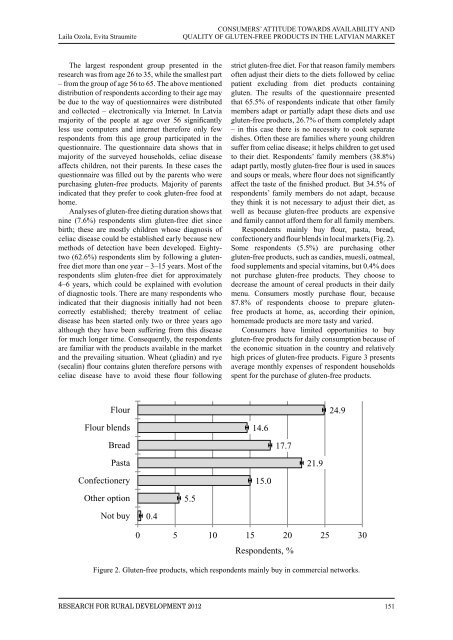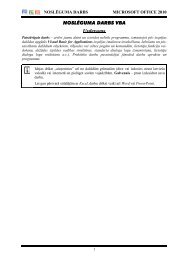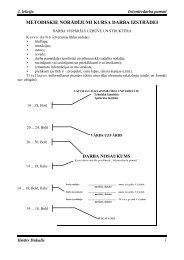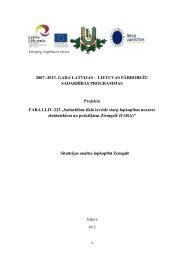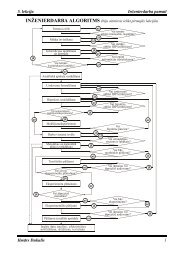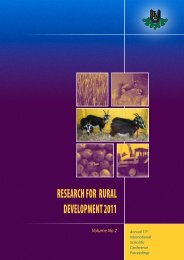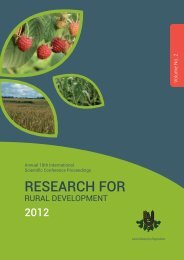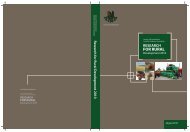LATVIA UNIVERSITY OF AGRICULTURE - Latvijas ...
LATVIA UNIVERSITY OF AGRICULTURE - Latvijas ...
LATVIA UNIVERSITY OF AGRICULTURE - Latvijas ...
- No tags were found...
Create successful ePaper yourself
Turn your PDF publications into a flip-book with our unique Google optimized e-Paper software.
Laila Ozola, Evita StraumiteCONSUMERS’ ATTITUDE TOWARDS AVAILABILITY ANDQUALITY <strong>OF</strong> GLUTEN-FREE PRODUCTS IN THE <strong>LATVIA</strong>N MARKETThe largest respondent group presented in the research was from age 26 to 35, while the smallest part – from thegroup of age 56 The to largest 65. The respondent above mentioned group presented distribution in the of strict respondents gluten-free according diet. For that to reason their family age may members be due to theway of questionnaires research was from were age distributed 26 to 35, while and the smallest collected part – electronically often adjust their via diets Internet. to the diets In followed Latvia by majority celiac of thepeople at age – from over the 56 group significantly of age 56 to 65. less The use above computers mentioned and patient internet excluding therefore from only diet few products respondents containing from this agegroup participated distribution in of respondents the questionnaire. according to The their questionnaire age may gluten. data The shows results of that the in questionnaire majority presented of the surveyedhouseholds, be celiac due to disease the way affects of questionnaires children, were not distributed their parents. that In 65.5% these of cases respondents the questionnaire indicate that other was family filled out byand collected – electronically via Internet. In Latvia members adapt or partially adapt these diets and usethe parents who were purchasing gluten-free products. Majority of parents indicated that they prefer to cookmajority of the people at age over 56 significantly gluten-free products, 26.7% of them completely adaptgluten-freelessfooduseat home.computers and internet therefore only few – in this case there is no necessity to cook separateAnalyses of respondents gluten-free from dieting this age duration group participated shows that in the nine dishes. (7.6%) Often respondents these are families slim gluten-free where young diet children since birth;these are mostly questionnaire. children The whose questionnaire diagnosis data of shows celiac that disease in suffer could from be celiac established disease; it early helps children because to new get used methods ofdetection have majority been of developed. the surveyed Eighty-two households, (62.6%) celiac disease respondents to their slim diet. Respondents’ by following family a gluten-free members (38.8%) diet more thanone year – affects 3–15 years. children, Most not their of the parents. respondents In these cases slim the gluten-free adapt partly, diet mostly for approximately gluten-free flour 4–6 is used years, in sauces which couldbe explained questionnaire with evolution was filled of diagnostic out by the parents tools. who There were are and many soups respondents or meals, where who flour indicated does not significantly that their diagnosispurchasing gluten-free products. Majority of parents affect the taste of the finished product. But 34.5% ofinitially had not been correctly established; thereby treatment of celiac disease has been started only two or threeindicated that they prefer to cook gluten-free food at respondents’ family members do not adapt, becauseyears ago although they have been suffering from this disease for much longer time. Consequently, thehome.they think it is not necessary to adjust their diet, asrespondents are Analyses familiar of gluten-free with the dieting products duration available shows that in the well market as because and the gluten-free prevailing products situation. are expensive Wheat (gliadin)and rye (secalin) nine (7.6%) flour respondents contains gluten slim gluten-free therefore diet persons since with and family celiac cannot disease afford have them to for avoid all family these members. flour followingstrict gluten-free birth; these diet. are For mostly that children reason family whose diagnosis members of often Respondents adjust their mainly diets to buy the flour, diets pasta, followed bread, by celiacpatient excluding celiac disease from could diet products be established containing early because gluten. new The confectionery results of and the flour questionnaire blends in local presented markets (Fig. that 2). 65.5% ofrespondents methods indicate of that detection other have family been members developed. adapt Eightytwo(62.6%) respondents slim by following a gluten-gluten-free products, such as candies, muesli, oatmeal,or partially Some respondents adapt these (5.5%) diets and are use purchasing gluten-free other products,26.7% of them completely adapt – in this case there is no necessity to cook separate dishes. Often these arefree diet more than one year 3–15 years. Most of the food supplements and special vitamins, but 0.4% doesfamilies where young children suffer from celiac disease; it helps children to get used to their diet. Respondents’respondents slim gluten-free diet for approximately not purchase gluten-free products. They choose tofamily members 4–6 years, (38.8%) which adapt could partly, be explained mostly with gluten-free evolution flour decrease is used the amount in sauces of cereal and products soups or in meals, their daily where flourdoes not significantly of diagnostic affect tools. There the taste are many of the respondents finished who product. menu. But Consumers 34.5% of mostly respondents’ purchase family flour, members because do notadapt, because indicated they that think their it diagnosis is not necessary initially had to not adjust been their 87.8% diet, of as respondents well as because choose to gluten-free prepare glutenfreeproducts at home, as, according their opinion,products areexpensive and correctly family established; cannot afford thereby them treatment for all family of celiac members.Respondents disease mainly has been buy started flour, only pasta, two bread, or three confectionery years ago homemade and flour products blends are more in local tasty markets and varied. (Fig. 2). Somerespondentsalthough(5.5%)theyarehavepurchasingbeen sufferingotherfromgluten-freethis diseaseproducts,Consumerssuchhaveaslimitedcandies,opportunitiesmuesli,tooatmeal,buyfoodfor much longer time. Consequently, the respondents gluten-free products for daily consumption because ofsupplements and special vitamins, but 0.4% does not purchase gluten-free products. They choose to decrease theare familiar with the products available in the market the economic situation in the country and relativelyamount of cereal and the products prevailing in situation. their daily Wheat menu. (gliadin) Consumers and rye high mostly prices purchase of gluten-free flour, products. because Figure 87.8% 3 presents of respondentschoose to prepare (secalin) gluten-free flour contains products gluten therefore at home, persons as, according with average their monthly opinion, expenses homemade of respondent products households are more tastyand varied. celiac disease have to avoid these flour following spent for the purchase of gluten-free products.Flour24.9Flour blends14.6Bread17.7Pasta21.9Confectionery15.0Other option5.5Not buy0.40 5 10 15 20 25 30Respondents, %Figure 2. Figure Gluten-free 2. Gluten-free products, products, which which respondents mainly buy in in commercial networks. networks.Consumers have limited opportunities to buy gluten-free products for daily consumption because of theeconomic situation in the country and relatively high prices of gluten-free products. Figure 3 presents averageResearch for Rural Development 2012151monthly expenses of respondent households spent for the purchase of gluten-free products.


